[color=blue]A thousand years, a thousand more[/color]
[color=blue]A thousand times a million doors to eternity[/color]
[color=blue]I may have lived a thousand lives, a thousand times[/color]
[color=blue]An endless turning stairway climbs to a tower of souls[/color]
[color=blue]If it takes another thousand years, a thousand [b]wars[/b][/color]
[color=blue]The towers rise to numberless floors in space[/color]
[color=blue]I could shed another million tears, a million breaths[/color]
[color=blue]A million names but only one truth to face[/color]
[color=blue]A million roads, a million fears[/color]
[color=blue]A million suns, ten million years of uncertainty[/color]
[color=blue]I could speak a million lies, a million songs[/color]
[color=blue]A million [b]rights[/b], a million [b]wrongs[/b] in this balance of time[/color]
[color=blue]But if there was a single truth, a single light[/color]
[color=blue]A single thought, a singular touch of grace[/color]
[color=blue]Then following this single point, this single flame[/color]
[color=blue]This single haunted memory of your face[/color]
[color=blue]...[/color]
[color=blue]I may be numberless, I may be innocent[/color]
[color=blue]I may know many things, I may be ignorant[/color]
[color=blue]Or I could ride with [b]kings[/b] and [b]conquer[/b] many [b]lands[/b][/color]
[color=blue]Or [b]win[/b] this world at [b]cards[/b] and let it slip may hands[/color]
[color=blue]I could be cannon food, destroyed a thousand times[/color]
[color=blue]Reborn as fortune's child to judge another's crimes[/color]
[color=blue]Or wear this pilgrim's cloak, or be a common thief[/color]
[color=blue]I've kept this single faith, I have but one belief [/color]
[color=blue]...[/color]
[color=blue]I still love you, I still want you[/color]
[color=blue]A thousand times these mysteries unfold themselves[/color]
[color=blue]Like galaxies in my head[/color]
[color=blue]On and on the mysteries unwind themselves[/color]
[color=blue]Eternities still unsaid[/color]
[color=blue][b]'Til[/b] you love me [/color]
[color=blue][b]"A Thousand Years" by Sting[/b][/color]
[color=blue][b]Album: "All This Time" & "Brand New Day"[/b] [/color]
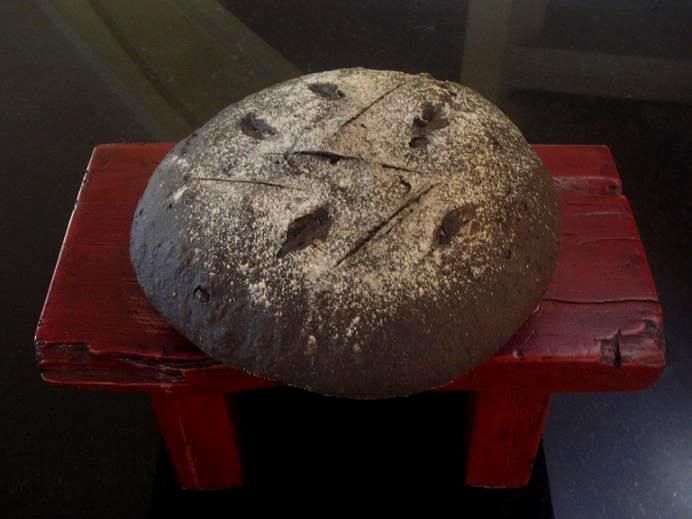
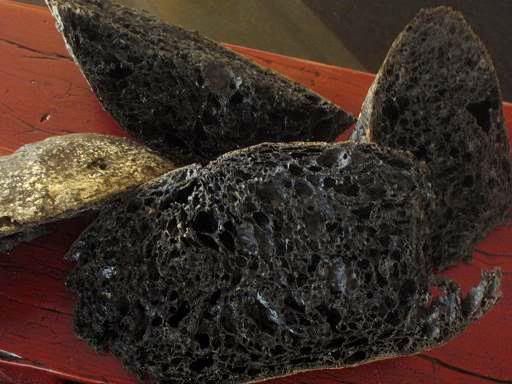
[b]This bread was inspired by Sting's A Thousand Years. [/b]
[b][u]My Formula[/u][/b]
- 200 g rye meal starter @ 100% hydration (built up in three feedings over 48 hours. I had to increase hydration from 75% and added 1/8 tsp sugar as the starter was looking tough going in rye meal flour.)
- 350 g white flour
- for colouring/saltiness/hydration: 28 g soy sauce + 12 g squid ink + 34 red wine
- 168 g water
- 1/8 tsp instant dry yeast (I was afraid I might have poisoned my starter with the squid ink and soy sauce so I added instant yeast. As it turned out my starter appeared to be strong enough.)
dough weight 792 g & dough hydration 76%
- Bulk fermentation 6 hours with 4 folds
- Shape then Proof 2 hours
- Overnight cold retardation 12 hours, followed by 2 hours at room temp
- Bake at 230 C for 20 min and 210 C for another 15 min, followed by 10 min resting in the oven with the door still shut but the oven turned off.
This morning I showed my son and daughter the fermented dough before their school; both of them turned up their noses without saying anything. My husband was more diplomatic.
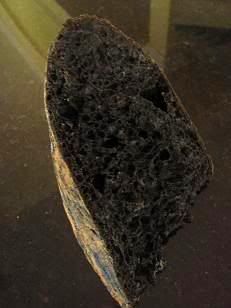
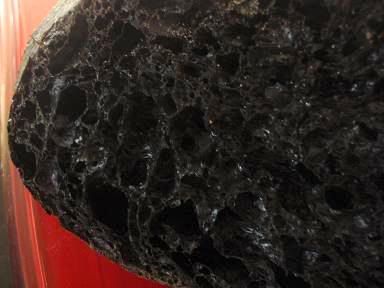
[b]Crumb ... and more crumb[/b]
Well, I have to say that I am very pleased with the result. My husband said the crumb was sensational (how supportive). The crust was thin and ultra crispy (to me, it is baguette crust standard).
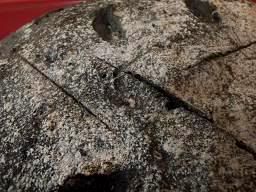
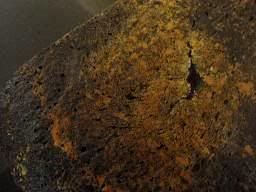
[b]top crust bottom crust[/b]
There was a very faint bitterness taste to the crumb, which I find adds to the depth of flavour. I asked my husband if he thought the bitterness was associated with the ink. He said, even if it was not, you would form that mental association because your senses subconsciously makes the linkage between black and bitterness.
Notwithstanding the faint bitterness, he likes the bread also because it is very moist; but he admits this inky bread is not his most favourite. For me, the inkiness is a strikingly sober colour that I like, at once ancient and modern. I once heard that many Americans like their first cup of coffee blace in the morning and why black? - because the bitterness provides counter-balance to their sweet diet. Your body actually craves for something bitter. Another example: why do pregnant women crave for sourness - their body needs Vitamin C contained in many sour fruits or food. I crave bitterness; not at all because this bread is bitter (it is not), it is the association that makes me welcome this bread.
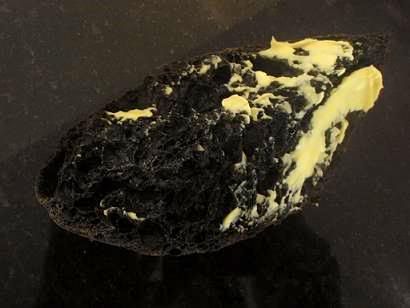
[b]My black abstract painting[/b]
Shiao-Ping
- Shiao-Ping's Blog
- Log in or register to post comments
struggling, still
Betty
Dinner tonight is spaghetti bolognaise and green salad. I made a huge portion enough for a whole week. I gave my son a slice of this bread with butter. He said oh chocolate bread! I am surprised he finished it without further ado. I asked my daughter if she'd like some. She said she already had a piece without invitation and she thinks the bread is interesting.
I once read a report that there are some colours that are "appetising," for instance, warm colours like yellow, orange, and brown. But, "cold" colours like blue and ... black ... are ... Hmmm... not so appetising. I haven't met anybody that like Italian ink pastas - can you imagine getting your teeth all black? Yuck. I am not surprised at your comment. Thanks for taking the time to write.
Shiao-Ping
I was referring to, sorry. My husband of 22 years passed away 9 years ago. I still struggle some days. The words touched me, very much. I am very fortunate to have remarried a most wonderful man.
Betty
my deepest sympathy.
Shiao-Ping
on the term "black bread"! Interesting that you mention how the ink pastas stain one's mouth. Is that not the case with this bread, too?
If you were to bake this in baguette form, it would make a striking base for canapes or hors d'oeurves. Think of the contrast with smoked salmon, or boiled egg, or a shaving of red pepper . . .
This might not make the best toast, though. Figuring out when it's done could be a real challenge. ;-)
Paul
Your comment is very interesting. I think the ink pastas stain mouths because of the sauce but the ink bread doesn't because there is no sauce.
I hadn't thought of it but this formula will make a fantastic baguette. I still couldn't work out why the crust is so good.
Shiao-Ping
I am just so impressed to see what new combinations you come up with! You are soooo creative! And the songs and people and philosophies that inspire your bread mutations - very interesting. And I remember a comment of yours recently that you have known sourdough for only barely over a half year. So remarkable!!
Oh, by the way, I made your walnut and sultana bread last week - it was such a delight!
Whenever I made something, I never have any confidence that anyone can reproduce it simply because some of my combinations are so non-main stream (and un-tested). I am glad to hear that the walnut and sultana turned out good for you.
Shiao-Ping
... since April this year (around Easter), but to be fair, I have been baking for years. You know if you buy a bread machine, it normally comes with a recipe book from the manufacturer, and in the recipe book, chances are there would be a raisin bread recipe that tells you to put in the raisins either when the machine beeps, or there may be a special compartment for you to put in those add-ins before you press the start button? Well, I would not do raisin bread on my bread machine for a second time and this was maybe 6 or 7 years ago; why? because, to satisfy my curiosity, I had to do something different - instead of raisins, I fed my machine (when it beeped) a combination of leftover sun-dried tomato and chopped up basil. This was around the time when I was introduced to pesto.
I was trying to think how sourdough has changed my breads over the last four months; there are at least the following improvements:
I looked through some of my old files and I found this yeasted bread that I made on April 13 this year:
This was a mashed pea & pesto bread. I took the pictures for my sisters in Taiwan. While I had not used this combination on bread up until then, just looking at the scoring I know it was a recent bread because I only learnt about scoring when I learnt about sourdough.
I think people who don't know about sourdough can still make very interesting breads; one thing, however, people who don't know about sourdough generally lack is the hand techniques. People who only use bread machine to make breads from start to finish generally have a fear of hand kneading and hand shaping, at least I did, but not any more. Before I learnt about sourdough, while I could take the dough out of my bread machine once it's done kneading, and shape it by hand into different molds, there was often a reluctance. Back in April/May/June, I still used bread machine to knead a lot. It was[b] James MacGuire [/b]who permanently expelled my fear of hand kneading.
Thanks for your comment and once again I am happy the walnut and sultana bread worked for you.
Shiao-Ping
... it's the same for me. That's when I finally decided to get a starter and of course, there is no turning back. However, I have been baking yeasted breads (savory and sweet ones) along with cakes, tortes, tartes, cookies, pastries, for many years.
What I think you did so very well is to "throw" yourself whole-heartedly into this new adventure. You mentioned somewhere that you were reading and researching day and night for a while, and I feel this is what brings success the fastest (and you are the best proof of this. The fact that you are so creative doesn't hurt either :). I have been reading and experimenting off and on, but when I don't work with the starter for three, four weeks, there are so many things that I have to look up again, because my knowledge (and experience) is not solidified. These last four weeks I have been researching and reading A LOT about it (there are SO many things to consider), ordering several books and going through them so that I slowly feel to be getting an O.K. grasp on so many factors that up until now I didn't consider much like the quality of flours and gluten/ash levels and which ones to use for which breads, etc.; the different folding techniques (or slap and fold), etc; all the things that can influence the outcome of the loaf in the oven, etc., etc. This site has been of tremendous help.
What had surprised me was that you even ordered books in languages that you don't speak (you mentioned that in a post at some time) and that you used the pictures for inspiration.
I am looking forward to your future breads and stories!
Sounds like our paths are similar. In the beginning I was really fascinated by all those seemingly different techniques (Bertinet's slap and fold that you mentioned is the best example of them); essentially they are doing the same thing - to build the dough strength at the same time allowing the fermentation to take place at a pace that is best for the flavor to develop. Like you, I have tried many techniques, and now I feel fancy techniques are not necessary. My black marble counter-top used to be a war-zone with flour every where and gadgets, you name it. It was painful to clean it up every time to the point I dread thinking of my next loaf. It may sound funny but I think [b]that[/b] on top of the fear of failure (eg. the first time I made baguette I literally brutalised the dough) make me think it's a wonder that I am still making breads. Since I came across James MacGuire's formula, my kitchen is a pleasure to be in any time - almost no clean up required afterwards. It is not the utility side of this so-called "artisan breads" that is the driving force of my baking. Frankly my family doesn't need breads; there are so many other just as interesting alternatives for the starchy component of a meal - grilled polenta wadges, soft milky polenta, Yorkshire puddings, sweet potatoes (purple, or yellow, or orange, or red, or even white; baked, or mashed, or made into souffle like dish, or a soupy consistency to garnish whatever's happening on the plate); the list can go on. I think many TFL users would agree that they make sourdoughs because that gives them a sense of creativity, that they are still in touch with life's most basic ingredient, and that, well, is something that you can share with family and friends, or just with yourself!
Shiao-Ping
... and I totally agree. The driving side is not necessarily the utility (in the meantime, through this artisan bread revival pretty much anywhere, one can certainly buy superb sourdough and other breads in quite a few bakeries - however, they are treated as luxury goods in my opinion, when you have to pay anywhere from over $5 to 7 dollars for a really good loaf) but the fact that it is a creative endeavour, a hobby, a passion really and also the possibility to make breads nowhere else available and, as you point out, the perfect gift for friends and neighbors.
I just want to get to a comfort level with sourdough where I can make a good loaf without having to read/research/experiment too much beforehand. And to get there, I'll have to read, research, and experiment quite a bit more :)
Have been revisiting this site for a number of years now but first time to comment here today. Can I say that I find your posts very inspiring and creative, thank you for taking the time to share. Reading through many of your recipes I noticed you often make notes on the type of flour and it's suitability for certain recipes which left me -a beginner - somehow puzzled. If it's not too much to ask, could you please give me some hints on flour selections in Australia. Appreciate your advise and anyone else's here.
Thanks for writing on my blog. I blushed on your comment that I gave flour suitability for my recipes; if I did, it was an accident. I often wanted to find "all-purpose" flour, but wasn't able to in Australia (they say a combination of 1/2 bread flour and 1/2 all-purpose flour would get you something closest to French artisan flour). In the supermarkets in Australia, the two main categories of flour are Plain flour (like Bread flour in America) and Self-Raising flour (with baking powder and perhaps other raising agents added as well for cake making). And both categories come in white or wholemeal. These are the four main types of flour in Australia. Other than these, there are also more specialty flours in organic stores which I have started using with my sourdough breads, and are mainly organic unbleached white (or wholemeal) flours.
It was suggested to me by a TFL user that the wholemeal flour in Australia is generally White whole wheat flour because White wheat is generally the type of wheat that is grown in Australia, whearas in America you have Red wheat. It was sugggested to me that "American white whole wheat is derived from Australian wheat. It took a couple of decades to develop strains which our (ie, North American) climate could support. Traditional American whole wheat has a red bran coat from anthocyanin pigments - which because of their polyphonolic qualities have a slight, undesireable bitterness. The white varieties lack as much of the anthocyanins."
In terms of flours, I play with what I have or can get hold of; I really don't know much about them.
Shiao-Ping
Thank you sooo much Shiao-Bing for your time and generousity, it's kind people like yourself that encourage me to keep on baking. Your reply to my query is very informative.
The following might not be of much interest to those who don't live in Australia, but for those who live downunder and are trying to find aternatives to the supermarket flour they might wish to check this out. I have tried before a 12.5 kg bag of Bakers Flour by Manildra Group http://www.manildra.com.au/. I mostly used it to bake the famous NYT no-kneed bread with good results. Last week I bought a 12.5 kg bag of Protein Enriched Flour by same manufacturer. The bag doesn't state protein percentage, but I have noticed that the Protein Enriched gives a very pliable dough especially with wet dough. They supply a big variety of of different flours that are available to the public from wholesale food suppliers.
Most of my baking so far falls under the experimental gategory, but with the wealth of knowledge and generousity of the TFL members hopefully I'll have some baking to post in the near future. In the meantime I'm a very grateful subscriber.
p.s. I didn't graduate in 97, I graduated 87, so why di I use 97grad as my user name you ask, I have no idea, I guess I have a weird spot.
I wasn't sure where you were when I wrote what I wrote. With the information you gave, it makes me think flours are quite area specific within a country - I've never seen Manildra brand in Queensland. Over my way, I get Laucke (South Australian based) and Kialla Pure (Queensland based) a lot. I guess what brand is not important, what we want to know is what type of flour it is. You mentioned protein enriched flour and from your description, it sounds similar to high protein flour which is generally capable of absorbing more water and gives more [b]volume[/b].[b] Susan from San Diego [/b]is a great baker who uses high protein flour with great success. I learnt a lot from Susan. (Note: her General Mills All-Trumps is a high gluten flour.) You might want to check out her blog. Regards, Shiao-Ping
Thanx for recommending Susan's blogs, I've been through a few and find it very useful. Thanks again
The photos of the crumb remind me of lava rock - it's interesting to me how the color makes the bread appear hard instead of soft. Very creative!
I still couldn't work out why the crumb is so soft (ie. moist). Very often my crumb is soft because of the presence of oil. I wonder if I subsituted a portion of the 168 grams of water with olive oil (say up to 5% baker's percentage or 15 - 20 g?)
Sometimes I did my calculations in a piece of paper and when measuring the ingridents for the dough, I added something extra at the last minute. I normally would remember to go back and correct what I wrote on the paper because I would look at the notes and immediately knew it's not entirely right. But in the case of this inky bread, I can't remember now. In the odd chance that you want to try making the bread, it wouldn't hurt to add some olive oil.
Shiao-Ping